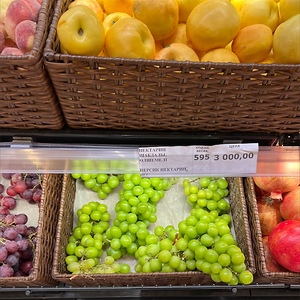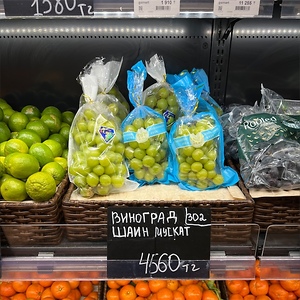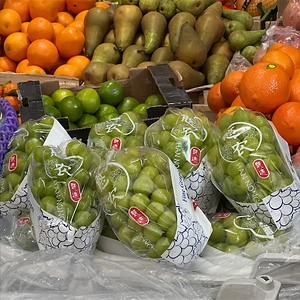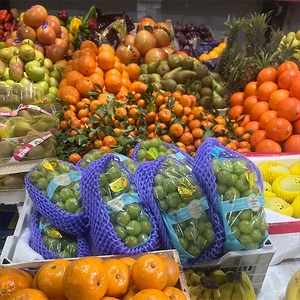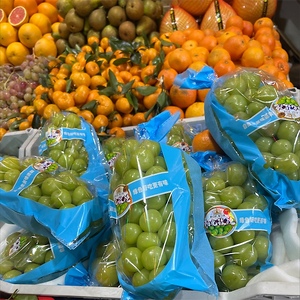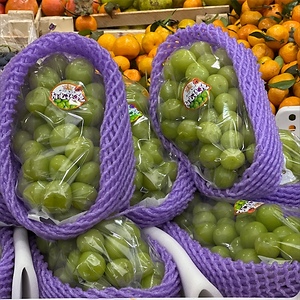


Green Muscat Grapes
Estimated Inventory, 18 lbs : 2.50
This item was last sold on : 07/25/25
Description/Taste
Muscat grapes vary in size and shape, depending on the specific variety, but are typically small to medium types with tapered, conical to cylindrical bunches. Each grape has a round to oval shape and features smooth, taut, and firm skin. Muscat grapes appear in shades of green, green-white, pale pink, amber, dark red, purple, and black. Most grapes categorized as green or white types will have lighter skin tones, occasionally blushed with pink patches. Underneath the surface, the translucent flesh is plump, soft, and aqueous. Muscat grapes are seeded or seedless, varying with the type, and the skin's firmness creates a crisp, contrasting consistency with the softness of the flesh. Muscat grapes are known for their perfumed, musky aroma filled with floral, honey, and fruity notes. The grapes are edible raw or cooked once ripe and have a sweet, sugary, and rich flavor with fruity nuances reminiscent of oranges, mangoes, peaches, and apricots.
Seasons/Availability
Muscat grapes are available in the summer through fall.
Current Facts
Muscat grapes, botanically classified as Vitis vinifera, encompass many types of aromatic varieties belonging to the Vitaceae family. Over two hundred varieties are currently sold under the general Muscat name worldwide, and these grapes are commercially cultivated and planted in home gardens as a multi-purpose fruit. Muscat grape varieties are believed to be some of the oldest cultivated grapes and have been extensively documented throughout history for their use as table grapes, winemaking grapes, and raisins. The most common green and white Muscat grapes varieties include Muscat Blanc à Petits Grains, Moscato Giallo, Muscat of Alexandria, and Muscat Ottonel. These types are used for winemaking and table grapes. Other types of seedless Muscat grapes have also been bred specifically for table grapes, such as Shine Muscat, Cannon Hall Muscat, Delight, and Golden Muscat. In the modern day, Muscat grapes are a versatile category of varieties used for varying purposes worldwide. As a table grape, the fruits are favored for their strong aroma, sweet flavor, and juicy, succulent nature. Muscat grapes are a seasonal delicacy and are utilized in a wide array of fresh and cooked preparations.
Nutritional Value
Muscat grapes are a source of vitamins A and C to strengthen the immune system and maintain healthy organs. The grapes also provide fiber to regulate the digestive tract, potassium to balance fluid levels within the body, magnesium to control nerve functions, and calcium to support bones and teeth. Other nutrients include iron, which develops the protein hemoglobin for oxygen transport through the bloodstream. Muscat grapes notably contain monoterpenes, organic compounds contributing to the grape’s distinct aroma. Types of grapes belonging to the Muscat group are known for their floral, fruity, and heady scent, and this fragrance has been documented throughout history. One of the most famous references was by Roman naturalist and author Pliny the Elder. In his work “Natural History,” written sometime between 77 and 79 CE, Pliny the Edler mentions that Muscat grapes are known as “the grape of the bees” for their pleasant smell.
Applications
Muscat grapes have an aromatic, fruity, floral, and honeyed flavor suited for raw and cooked preparations. Each type of Muscat grape will vary in flavor and use, but generally, the grapes can be served fresh, out of hand, as a table grape. Muscat grapes can also be displayed on cheese boards, halved and tossed into salads, or used as a topping over yogurt drizzled with honey. The grapes are occasionally blended and frozen into sorbet, frozen whole and dropped into drinks as edible ice cubes, or sliced and used as a decorative garnish on cakes and desserts. In Europe and Japan, Muscat grapes are often baked into tarts, Danishes, cakes, and clafoutis. They are also skewered and dipped into a hot sugar syrup, which is hardened to make a crunchy shell. The skewered grapes are served as popular street food in Asia and are consumed as a dessert or snack. In Europe, Muscat grapes are dried into raisins and simmered into jams, jellies, and syrups. They are also incorporated into various savory dishes, especially with meats such as duck, beef, pork, or poultry. Worldwide, some types of Muscat grapes are pressed into juices, muddled into cocktails, or made into wine. Muscat grapes pair well with other fruits such as figs, apples, strawberries, pears, and bananas, nuts such as pecans, almonds, and pine, cheeses such as brie, feta, and goat, and herbs such as basil, dill, thyme, sage, and rosemary. Whole, unwashed Muscat grape bunches will last for one week when stored in a container in the refrigerator.
Ethnic/Cultural Info
Muscat grapes are deeply intertwined in the history of viticulture, the science and art of cultivating grapevines for winemaking. The first written documentation of Muscat grapes in the 13th century references the variety in winemaking, and experts often suggest that they may have been used much earlier as a wine grape throughout the Eastern Mediterranean. Muscat grapes are believed to be the only grape type that produces wine with the same aroma as the grape itself. The vines thrive in warm, dry, Mediterranean-like climates and are adaptable, allowing the grapes to be used in several types of wine, from sparkling and sweet to dry wines. Muscat grapes are widely cultivated in Greece, and winemaking is tied to Dionysus, the god of wine, fertility, fruits, and theater. Many stories of Dionysus are told throughout Greek mythology, and the son of Zeus is often depicted wearing vines, holding a drinking cup, and carrying a pinecone-tipped staff. One ancient superstition in Greece involved winemakers placing Dionysus masks in their vineyards. Legend has it that the masks would blow in the wind, and the direction the mask faced would predict where the most fruitful vines would grow that season.
Geography/History
Muscat grapes are an ancient category of some of the earliest cultivated types of grapes in history. The origins of the first Muscat grapes are unknown, but historians hypothesize possible origination sites in the Eastern Mediterranean, the Arabian Peninsula, or North Africa. Muscat grapes were spread over time through traveling merchants and traders, expanding their presence throughout the Mediterranean. The grapevines were extensively cultivated in Ancient Egypt, Persia, Greece, and Rome, creating new varieties and types. The first documentation of Muscat grapes was recorded in a 13th-century document written by English Franciscan Scholar Bartholomaeus Anglicus in his work “De Proprietatibus Rerum.” Muscat grapes were later spread to Russia, Germany, other parts of Europe, and Asia. In the 1840s, types of Muscat grapes were introduced to California and were planted as table grapes by the 1850s. Muscat grapes were also introduced to South Africa, Australia, and New Zealand in the mid-19th century. Today, many types of Muscat grapes are grown worldwide, with concentrated production in Greece, France, Italy, Spain, Portugal, Germany, Australia, South Africa, and California in the United States. When in season, Muscat grapes are sold as table grapes through select farmer’s markets, retailers, and wholesalers, dried for raisins, or grown for wine and juice production.
Featured Restaurants
Restaurants currently purchasing this product as an ingredient for their menu.
| Gata | La Jolla CA | 858-336-5550 |
| Rancho Santa Fe Golf Club | Rancho Santa Fe CA | 858-756-1582 |
| Fairmont Grand Del Mar | San Diego CA | 858-314-1975 |
| Fifty Two Remedies | San Diego San Diego | 858-707-7016 |
| A & M catering | San Diego CA | 206-802-8320 |
| Jeune Et Jolie | Carlsbad CA | 858-231-0862 |
| Beaumont's | San Diego CA | 858-459-0474 |
| Salt & Whiskey | San Diego CA | 619-544-1886 |
| The Guild Hotel | San Diego CA | 619-764-5108 |
| Sensations Salud | San Diego CA | 619-933-3489 |
| Addison Del Mar | Del Mar CA | 858-350-7600 |
| Tribute Pizza | San Diego CA | 858-220-0030 |
| Searcher Sportfishing | San Diego CA | 619-861-4640 |
| Javier Plascencia (Animalon) | Bonita CA | 619-295-3172 |
| The Seabird Resort | Oceanside CA | 442-222-9505 |
Recipe Ideas
Recipes that include Green Muscat Grapes. One
| LA Weekly |
|
Muscat Grape Dessert |
| Salt and Pepper Skillet |
|
Panna Cotta & Muscat Grape Granita |



